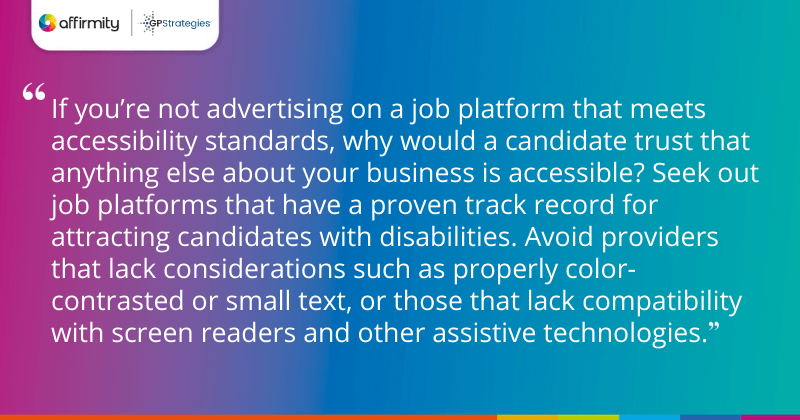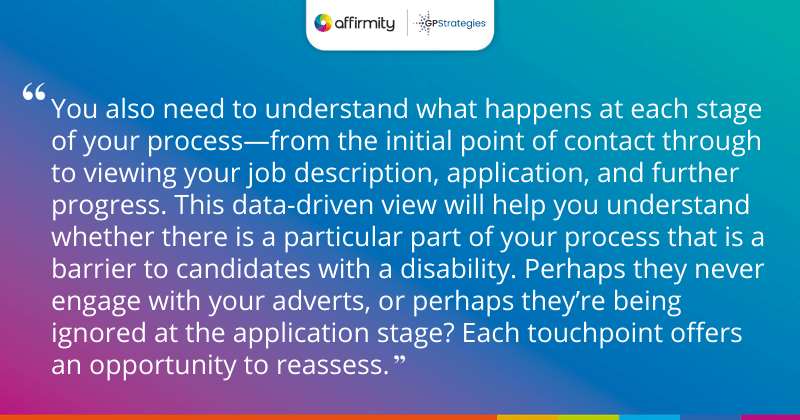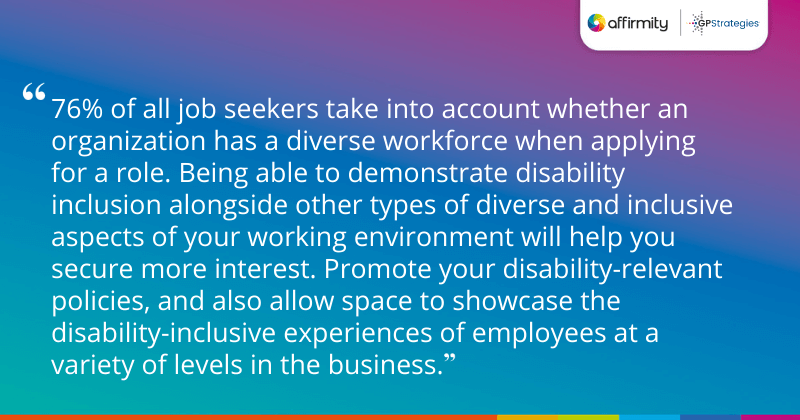Is your organization doing everything it can to be an attractive employer for disabled candidates? You may be unknowingly turning away highly talented employees with any and all aspects of your recruitment process. From studying your diversity analytics to improving the language in your job specifications, read on to discover six best practices.
One billion people globally live with a disability, accounting for around 15% of the global population. Nonetheless, people with disabilities are significantly less likely to be represented in the workforce. The US Bureau of Labor Statistics suggests that in 2020, 17.9% of persons with a disability were in employment—compared with 61.8% of those without a disability. Closing this gap is a social responsibility, but as with any form of change towards a more diverse and inclusive organization, attracting more candidates with disabilities could offer a competitive advantage.
1) Accessibility Begins With Where You Post Your Positions
It was once claimed that the average candidate takes only 49.7 seconds to decide that a job isn’t right for them—a very short window to convince a great candidate that they would be a good fit. For every second of that time, they’ll be looking for red flags that disqualify you immediately. For applicants with a disability, accessibility is a real sticking point.
This starts with where you list the position. If you’re not advertising on a job platform that meets accessibility standards, why would a candidate trust that anything else about your business is accessible? Seek out job platforms that have a proven track record for attracting candidates with disabilities. Avoid providers that lack considerations such as properly color-contrasted or small text, or those that lack compatibility with screen readers and other assistive technologies.

2) Focus on Writing Inclusive Job Descriptions
The way your job descriptions are phrased and structured can also send up red flags for your candidate. You may be writing non-inclusive job descriptions if you use:
- Ableist terms such as ‘crazy’, ‘visionary’, or ‘mobile’.
- Clichéd, ultimately ableist requirements such as ‘thrives in a busy environment’.
- Complex language. Shorter sentences are easier to read. Shorter job descriptions show that you already have a clear idea of what is important about both the role and the person who will fill it. We recommend somewhere between 300 to 650 words.
Additionally, don’t rely solely on a standardized ‘equal opportunities statement’. These statements tend to focus on vague principles and obligations rather than practical steps. Instead aim to write a clear inclusion statement that includes references to accommodations that you will make during the recruitment process.
INFORMATION FOR FEDERAL CONTRACTORS | ‘The Why, How, and What of Good Faith Efforts: Why GFEs Are Important’
3) Collect Diversity Data and Use It
Driving recruitment of disabled people is easier with a data-driven approach. You need to understand your hiring patterns up to this point to get a good understanding of what you have to do to improve them. You also need to understand what happens at each stage of your process—from the initial point of contact through to viewing your job description, application, and further progress.
This data-driven view will help you understand whether there is a particular part of your process that is a barrier to candidates with a disability. Perhaps they never engage with your adverts, or perhaps they’re being ignored at the application stage? Each touchpoint offers an opportunity to reassess. Maybe you should rewrite your adverts. Maybe more work needs to be done to accommodate the needs of interviewees. Continued measurement of these touchpoints will lead to continual improvement.

4) Train Your Hiring Managers and Recruiters
Candidates with disabilities often find that regardless of being fully able to do a job, they’ll still get rejected because of the views and biases of hiring professionals. Sometimes this is from a misguided belief that a candidate would be at physical or emotional risk if they took the job. It’s critical that everyone responsible for hiring in your organization receives DE&I training to highlight and challenge these viewpoints. You should also use tools that eliminate the scope for bias in the process.
Recruitment teams don’t need to be all-knowing experts on disability, but they should know local equality and labor laws, and should be able to advise hiring managers accordingly. They must also be experts in the organization’s approach to adhering to these laws. Therefore, this knowledge should be embedded within the onboarding and skills development for recruitment roles.
It’s important to understand there is no ‘one size fits all’ approach. Disability-inclusive recruitment isn’t about checklists. It’s about letting disabled candidates and employees feel comfortable about sharing their individual needs, and it’s about those same individuals feeling assured that their needs will be met.
MORE FROM THE BLOG | ‘How to Create a Veteran-Fueled Business [Q&A]’
5) Proactively Make Accommodations for Applicants
Candidates may hesitate to ask for reasonable adjustments to your recruitment process. By proactively discussing the possibility of adjustments with everyone, you’ll show that applicants won’t be discriminated against because they require them. Bear in mind that you cannot ask candidates about disabilities or impairments, but you can ask about the accommodations you can make. Your approach to implementing these accommodations will need to be flexible—people’s requirements will be different. This helps to build trust that you are committed to disability inclusion and demonstrates the organization’s capacity to listen to and believe its employees.
You will also need to train hiring managers on the organization’s accessibility responsibilities and how to implement accommodations when requested. For example, if a candidate requests software to assist with the completion of an assessment, your hiring manager should know what this means, how to implement it, and where they can go for further support.

6) Show How You’re Already Acting Inclusively
76% of all job seekers take into account whether an organization has a diverse workforce when applying for a role. It therefore stands to reason that being able to demonstrate disability inclusion alongside other types of diverse and inclusive aspects of your working environment will help you secure more interest. You should promote your disability-relevant policies (including disability leave, workplace health strategies), and also allow space to showcase the disability-inclusive experiences of employees at a variety of levels in the business. You can also be open and honest about what you intend to address—it’s better to be upfront and authentic, as candidates can usually tell when you’re overpromising.
WHAT NEXT? | ‘5 Inclusive Mindsets That Create Better Businesses for Employees With Disabilities’
Did you know Affirmity offers a range of data and training solutions that will help you build a more disability-inclusive organization? Contact us today to find out more.
A version of this article originally appeared on theglobalrecruiter.com
 About the Author
About the Author
Eleanor Goichman Brett is a Global Inclusion Consultant at GP Strategies. Having completed a dissertation in the unconscious bias of attractiveness, she has also worked at Virgin Media, the Alzheimer’s Society and Ciklum Software to implement internal diversity and inclusion and accessibility strategies. With a motto of ‘data, action, data’, Eleanor helps organizations not only design and implement inclusion and learning plans that are right for them but also ensure measurement and sustainability.
